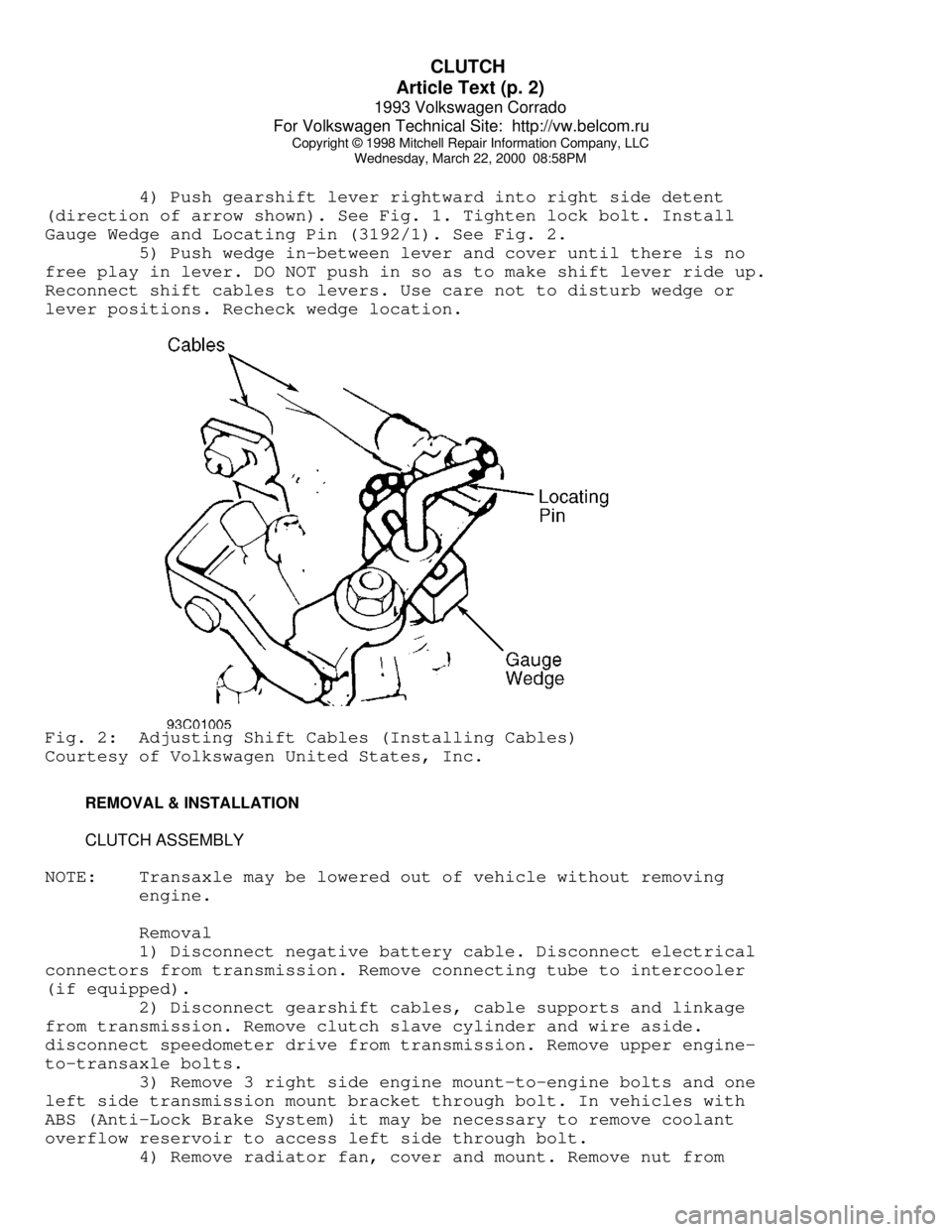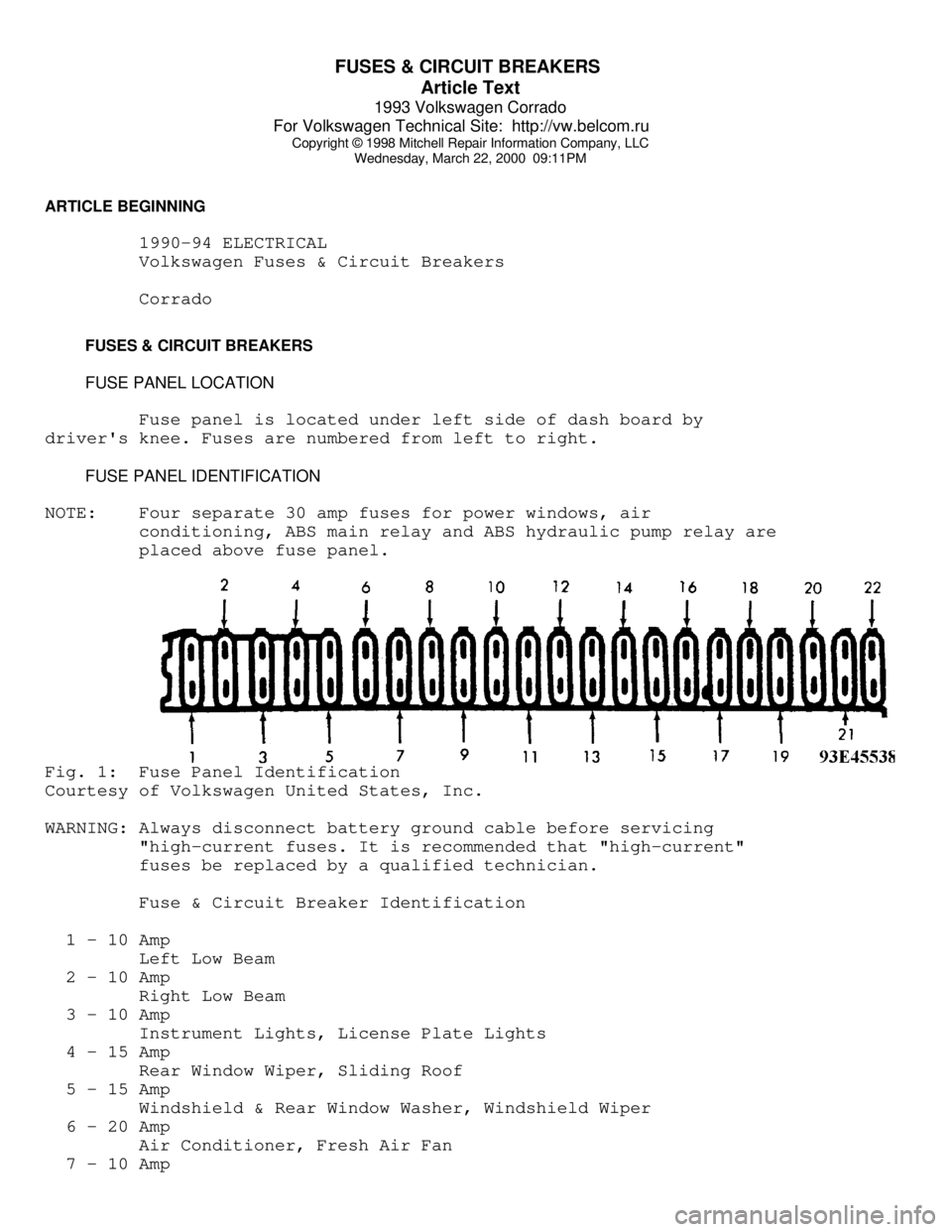1993 VOLKSWAGEN CORRADO battery location
[x] Cancel search: battery locationPage 388 of 920

AA - USING THIS SECTION (GENERAL HELP INFORMATION)
Article Text (p. 2)
1993 Volkswagen Corrado
For Volkswagen Technical Site: http://vw.belcom.ru
Copyright © 1998 Mitchell Repair Information Company, LLC
Wednesday, March 22, 2000 08:49PM
If you want "TUNE-UP" type information, see D - ADJUSTMENTS
for the adjustment procedures. If you are familiar with the
procedures, but need a quick way to find the specification, go to C -
TUNE-UP SPECS or C - SPECIFICATIONS for the specifications pertaining
to the vehicle.
When diagnosing driveability problems, first go to F - BASIC
TESTING. This article is here to help eliminate wasted diagnostic
time. If the basic systems are working properly, go to G - TESTS W/
CODES.
If the vehicle still is having a driveability problem or if
the vehicle has no self-diagnostic system, go to H - TESTS W/O CODES.
This article will help you diagnose the problem by symptom, locate the
symptom exhibited by the vehicle, and inspect or test the items which
may be causing the problem.
After finding which specific system or component requires
testing, use the I - SYS/COMP TESTS article to tests the systems and
components. We have also included (when available) pin voltage charts
and sensor range charts. These can be found in J - PIN VOLTAGE CHARTS
and K - SENSOR RANGE CHARTS.
Also included in this section are wiring diagrams and vacuum
diagrams. These can be found in L - WIRING DIAGRAMS and M - VACUUM
DIAGRAMS.
When all diagnostic tests have been performed and the problem
has been discovered, it may be necessary to replace or overhaul the
defective part. This information can be found in
N - REMOVE/INSTALL/OHAUL.
The content of each of these articles is outlined below. As a
summary of the driveability diagnosis, see ROUTINE OUTLINE in this
article.
A - ENGINE/VIN ID
This article shows how to identify the model and engine by
its Vehicle Identification Number (VIN). A model coverage chart shows
each model and engine, the fuel system, ignition system and engine
code. The engine serial number locations are also included in this
article.
B - EMISSION APPLICATION
These charts identify the emission systems and sub-systems
applicable to each model and engine combination.
C - TUNE-UP SPECS
This is a collection of quick-reference type specifications.
This article is helpful when you are familiar with proper adjustment
procedures and only need specifications. Included in this section are:
* Battery specifications.
* Fluid capacities.
Page 423 of 920

ANTI-THEFT SYSTEM
Article Text
1993 Volkswagen Corrado
For Volkswagen Technical Site: http://vw.belcom.ru
Copyright © 1998 Mitchell Repair Information Company, LLC
Wednesday, March 22, 2000 08:57PM
ARTICLE BEGINNING
1993 ACCESSORIES & EQUIPMENT
Volkswagen Anti-Theft
Volkswagen; Corrado SLC, Passat
DESCRIPTION & OPERATION
The anti-theft system monitors the radio, all doors, hood and
trunk lid position. When the anti-theft system is activated, The horn
and emergency flashers will be activated and the vehicle will not
start. The windows and sun roof (if equipped) are not monitored.
The anti-theft system has self-diagnostic capabilities that
monitor all components and wiring harness. If the system is
functioning correctly, the horn will sound briefly after front door is
locked with the key.
ANTI-THEFT CONTROL MODULE LOCATION TABLEÄÄÄÄÄÄÄÄÄÄÄÄÄÄÄÄÄÄÄÄÄÄÄÄÄÄÄÄÄÄÄÄÄÄÄÄÄÄÄÄÄÄÄÄÄÄÄÄÄÄÄÄÄÄÄÄÄÄÄÄModel Location
Corrado SLC ...................... Behind Right Kick Panel
Passat ...................... Driver Side Fuse/Relay Panel
ÄÄÄÄÄÄÄÄÄÄÄÄÄÄÄÄÄÄÄÄÄÄÄÄÄÄÄÄÄÄÄÄÄÄÄÄÄÄÄÄÄÄÄÄÄÄÄÄÄÄÄÄÄÄÄÄÄÄÄÄ TROUBLE SHOOTING
SYSTEM DOES NOT OPERATE
NOTE: Ensure battery is fully charged and all fuses are okay.
1) Ground Circuit Check
Obtain radio security code. Disconnect battery cable
terminals. Disconnect anti-theft control module 6-pin and 10-pin
wiring harness connector. See ANTI-THEFT CONTROL MODULE LOCATION
table. Connect ohmmeter negative lead to ground. Connect positive lead
to anti-theft control module 10-pin wiring harness connector terminal
No. "3" (Brown wire). If continuity is present, go to next step. If
continuity is not present, repair open circuit.
2) Power Circuit Check
Connect battery cable terminals. Connect voltmeter negative
lead to ground. Connect positive lead to anti-theft control module 6-
pin wiring harness connector terminal No. "3" (Red wire). Switch
positive lead to anti-theft control module 10-pin wiring harness
connector terminal No. "1" (Red wire). If 12 volts are present at both
terminals, go to next step. If 12 volts are not present, repair open
circuit.
3) Turn ignition on. Leave voltmeter negative lead connected
to ground. Connect positive lead to anti-theft control module 10-pin
wiring harness connector terminal No. "4" (Black wire for Corrado;
Page 424 of 920

ANTI-THEFT SYSTEM
Article Text (p. 2)
1993 Volkswagen Corrado
For Volkswagen Technical Site: http://vw.belcom.ru
Copyright © 1998 Mitchell Repair Information Company, LLC
Wednesday, March 22, 2000 08:57PM
Black/Yellow wire for Passat). If 12 volts are present, go to next
step. If 12 volts are not present, repair open circuit.
4) Alarm Horn Check
Turn ignition off. Connect ohmmeter negative lead to ground.
Connect positive lead to anti-theft control module 6-pin wiring
harness connector terminal No. "4" (Black/Yellow wire). If continuity
is present, go to next step. If continuity is not present, repair open
circuit. If circuit is okay, replace alarm horn.
5) Door Lock Switch Check
Connect voltmeter negative lead to ground. Connect positive
lead to anti-theft control module 10-pin wiring harness connector
terminal No. "7" (Red/Yellow wire for Corrado; Yellow/Red for Passat).
Insert key in driver's door lock. Turn key to lock position and hold
momentarily. Voltmeter should register 12 volts. Repeat procedure for
passengers door. If voltage is correct for each door, go to next step.
If voltage is not correct, repair open circuit or replace switch.
6) Door Lock Switch Check
Connect voltmeter negative lead to ground. Connect positive
lead to anti-theft control module 10-pin wiring harness connector
terminal No. "6" (Red/Black wire). Insert key in driver's door lock.
Turn key to unlocked position and hold momentarily. Voltmeter should
register 12 volts. Repeat procedure for passengers door. If voltage is
correct for each door, go to next step. If voltage is not correct,
repair open circuit or replace switch.
7) Alarm Switch & Hood Check
Connect ohmmeter negative lead to ground. Disconnect negative
battery cable. Connect positive lead to the following anti-theft
control module connector terminals:
* 10-pin harness connector terminal No. "5" (Gray wire).
* 10-pin harness connector terminal No. "8" (Brown/Red wire).
* 10-pin harness connector terminal No. "9" (Brown/Green wire).
* 10-pin harness connector terminal No. 10 (Brown/White wire for
Corrado SLC; Brown/Green wire for Passat).
If continuity is present, check for circuit short to ground. If
circuit is okay, replace switch. If continuity is not present, go to
next step.
8) Indicator Light Check
Leave ohmmeter negative lead connected to ground. Connect
negative battery cable. Using multimeter set on 10 A DC scale, connect
positive lead to anti-theft control module 10-pin wiring harness
connector terminal No. "2". If indicator light comes on, replace anti-
theft control module. If indicator light does not come on, repair open
circuit in wiring harness.
ALARM SYSTEM WILL NOT SWITCH OFF
1) Ground Circuit Check
Ensure battery is fully charged. Obtain radio security code.
Disconnect battery cable terminals. Disconnect anti-theft control
module 6-pin and 10-pin wiring harness connector. See ANTI-THEFT
CONTROL MODULE LOCATION table. Reconnect battery cable terminals.
2) Connect voltmeter negative lead to ground. Connect
Page 425 of 920

ANTI-THEFT SYSTEM
Article Text (p. 3)
1993 Volkswagen Corrado
For Volkswagen Technical Site: http://vw.belcom.ru
Copyright © 1998 Mitchell Repair Information Company, LLC
Wednesday, March 22, 2000 08:57PM
positive lead to anti-theft control module 10-pin wiring harness
connector terminal No. "7" (Red/Yellow wire for Corrado SLC;
Yellow/Red wire for Passat). Insert key in driver's door lock. Turn
key against stop and hold momentarily. Voltmeter should register 12
volts. Repeat procedure for passengers door. If voltage is correct for
each door, go to next step. If voltage is correct, repair door switch
or open circuit.
3) Door Lock Switch Check
Connect voltmeter negative lead to ground. Connect positive
lead to anti-theft control module 10-pin wiring harness connector
terminal No. "6" (Red/Black wire). Insert key in driver's door lock.
Turn key against stop and hold momentarily. Voltmeter should register
12 volts. Repeat procedure for passengers door. If voltage is correct
for each door, replace control module. If voltage is not correct,
repair door switch or open circuit.
ALARM HORN INOPERATIVE
1) Alarm Horn Check
Ensure battery is fully charged. Obtain radio security code.
Disconnect battery cable terminals. Disconnect anti-theft control
module 6-pin and 10-pin wiring harness connector. See ANTI-THEFT
CONTROL MODULE LOCATION table.
2) Connect ohmmeter negative lead to ground. Connect positive
lead to anti-theft control module 6-pin wiring harness connector
terminal No. "4" (Black/Yellow wire). If continuity is present,
replace anti-theft control module. If continuity is not present, check
for open circuit and repair as necessary. If circuit is okay, replace
alarm horn.
LIGHTS DO NOT FLASH
1) Alarm Horn Check
Ensure battery is fully charged and emergency flasher system
is functional. Obtain radio security code. Disconnect battery cable
terminals. Disconnect anti-theft control module 6-pin and 10-pin
wiring harness connector. See ANTI-THEFT CONTROL MODULE LOCATION
table.
2) Connect voltmeter negative lead to ground. Connect
positive lead to anti-theft control module 6-pin wiring harness
connector terminal No. "1" (Black/White wire for Corrado SLC; Black
Yellow wire for Passat). Turn emergency flashers on. When lights flash
on, battery voltage should be present.
3) Remove voltmeter positive from terminal No. "1" and
connect to terminal No. "2" (Black/Green wire for Corrado SLC;
Green/Black wire for Passat). Turn emergency flashers on. When lights
flash on, battery voltage should be present. If voltage is correct,
replace anti-theft control module. If voltage is not correct, repair
open circuit in wiring harness between anti-theft control module and
lights.
ENGINE DOES NOT CRANK WITH ALARM SYSTEM OFF
Page 426 of 920

ANTI-THEFT SYSTEM
Article Text (p. 4)
1993 Volkswagen Corrado
For Volkswagen Technical Site: http://vw.belcom.ru
Copyright © 1998 Mitchell Repair Information Company, LLC
Wednesday, March 22, 2000 08:57PM
1) Alarm Horn Check
Ensure battery is fully charged and emergency flasher system
is functional. Obtain radio security code. Disconnect battery cable
terminals. Disconnect anti-theft control module 6-pin and 10-pin
wiring harness connector. See ANTI-THEFT CONTROL MODULE LOCATION
table.
2) Reconnect negative battery cable. Connect voltmeter
negative lead to ground. Connect positive lead to anti-theft control
module 6-pin wiring harness connector terminal No. "5" (Red/Green wire
for Corrado SLC; Red/White wire for Passat). Observe voltmeter while
turning ignition to START position. If battery voltage is present, go
to next step. If battery voltage is not present, repair circuit to
ignition switch.
3) Remove ignition key. Disconnect negative battery cable.
Connect ohmmeter negative lead to ground. Connect positive lead to
anti-theft control module 6-pin wiring harness connector terminal No.
"6" (Red/Black wire for Corrado SLC; Violet/Black wire for Passat). If
continuity is present, replace anti-theft control module. If
continuity is not present, check wiring harness to starter for open
circuit.
WIRING DIAGRAMS
For wiring see WIRING DIAGRAMS article.
END OF ARTICLE
Page 447 of 920

CLUTCH
Article Text (p. 2)
1993 Volkswagen Corrado
For Volkswagen Technical Site: http://vw.belcom.ru
Copyright © 1998 Mitchell Repair Information Company, LLC
Wednesday, March 22, 2000 08:58PM
4) Push gearshift lever rightward into right side detent
(direction of arrow shown). See Fig. 1. Tighten lock bolt. Install
Gauge Wedge and Locating Pin (3192/1). See Fig. 2.
5) Push wedge in-between lever and cover until there is no
free play in lever. DO NOT push in so as to make shift lever ride up.
Reconnect shift cables to levers. Use care not to disturb wedge or
lever positions. Recheck wedge location.Fig. 2: Adjusting Shift Cables (Installing Cables)
Courtesy of Volkswagen United States, Inc.
REMOVAL & INSTALLATION
CLUTCH ASSEMBLY
NOTE: Transaxle may be lowered out of vehicle without removing
engine.
Removal
1) Disconnect negative battery cable. Disconnect electrical
connectors from transmission. Remove connecting tube to intercooler
(if equipped).
2) Disconnect gearshift cables, cable supports and linkage
from transmission. Remove clutch slave cylinder and wire aside.
disconnect speedometer drive from transmission. Remove upper engine-
to-transaxle bolts.
3) Remove 3 right side engine mount-to-engine bolts and one
left side transmission mount bracket through bolt. In vehicles with
ABS (Anti-Lock Brake System) it may be necessary to remove coolant
overflow reservoir to access left side through bolt.
4) Remove radiator fan, cover and mount. Remove nut from
Page 579 of 920

FUSES & CIRCUIT BREAKERS
Article Text
1993 Volkswagen Corrado
For Volkswagen Technical Site: http://vw.belcom.ru
Copyright © 1998 Mitchell Repair Information Company, LLC
Wednesday, March 22, 2000 09:11PM
ARTICLE BEGINNING
1990-94 ELECTRICAL
Volkswagen Fuses & Circuit Breakers
Corrado
FUSES & CIRCUIT BREAKERS
FUSE PANEL LOCATION
Fuse panel is located under left side of dash board by
driver's knee. Fuses are numbered from left to right.
FUSE PANEL IDENTIFICATION
NOTE: Four separate 30 amp fuses for power windows, air
conditioning, ABS main relay and ABS hydraulic pump relay are
placed above fuse panel.Fig. 1: Fuse Panel Identification
Courtesy of Volkswagen United States, Inc.
WARNING: Always disconnect battery ground cable before servicing
"high-current fuses. It is recommended that "high-current"
fuses be replaced by a qualified technician.
Fuse & Circuit Breaker Identification
1 - 10 Amp
Left Low Beam
2 - 10 Amp
Right Low Beam
3 - 10 Amp
Instrument Lights, License Plate Lights
4 - 15 Amp
Rear Window Wiper, Sliding Roof
5 - 15 Amp
Windshield & Rear Window Washer, Windshield Wiper
6 - 20 Amp
Air Conditioner, Fresh Air Fan
7 - 10 Amp
Page 607 of 920

HOW TO USE SYSTEM WIRING DIAGRAMS
Article Text (p. 4)
1993 Volkswagen Corrado
For Volkswagen Technical Site: http://vw.belcom.ru
Copyright © 1998 Mitchell Repair Information Company, LLC
Wednesday, March 22, 2000 09:11PM
When trying to locate a component in a wiring diagram and you
don't know the specific system where it is located, use this handy
component locator to find the system wiring diagram in which the
component is located. Then, go to that system and locate the component
within the wiring diagram.
For example, if you don't know the specific system in which
the ignition switch is located, look up ignition switch in the wiring
diagram component location tables and go to the appropriate wiring
diagram(s) which contain either full or partial views of the ignition
switch. The full view of the ignition switch is located in Power
Distribution.
The first listing for the component will be the full or most
complete view of the component. Additional listings will be partial
views of the component. Not all components are used on all models.
All components will have a partial view in Ground
Distribution and Power Distribution. Data Link Connectors show
connecting circuits between modules. Alternate names for components
may be listed in wiring diagram component locations tables.
WIRING DIAGRAM COMPONENT LOCATIONS TABLEÄÄÄÄÄÄÄÄÄÄÄÄÄÄÄÄÄÄÄÄÄÄÄÄÄÄÄÄÄÄÄÄÄÄÄÄÄÄÄÄÄÄÄÄÄÄÄÄÄÄÄÄÄÄÄÄÄÄÄÄÄÄÄÄÄÄÄÄÄÄComponent Wiring Diagram
ABS Electronic Control Unit ....................... Anti-Lock Brakes
Data Link Connectors
ABS Hydraulic Unit ................................ Anti-Lock Brakes
Acceleration Sensor ............................... Anti-Lock Brakes
Accessory Delay Relay ................................ Power Windows
A/C Compressor Clutch Relay ..................... Engine Performance
A/C Sensor ...................................... Engine Performance
A/C Pressure Switch ............................. Engine Performance
Adaptive Lamp Control Module ....................... Exterior Lights
Air Bag(s) ................................ Air Bag Restraint System
Air Bag Module ............................ Air Bag Restraint System
Air Bag Sensor(s) ......................... Air Bag Restraint System
Air Injection Pump Relay ........................ Engine Performance
Air Temperature Sensor ............................ Overhead Console
Alternator (Generator) ..................... Generators & Regulators
Anti-Theft Control Module ........................ Anti-Theft System
Starters
Autolamp Control Relay ........................... Headlight Systems
Daytime Running Lights
Automatic Shutdown (ASD) Relay .................. Engine Performance
Generators & Regulators
Autostick Switch ................................ Engine Performance
Auxiliary Battery Relay .................... Generators & Regulators
Back-Up Lights ...................................... Back-Up Lights
Exterior Lights
Barometric (BARO) Pressure Sensor ............... Engine Performance
Battery ......................................... Power Distribution
Battery Temperature Sensor ...................... Engine Performance